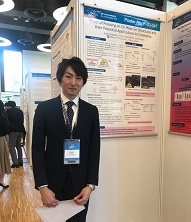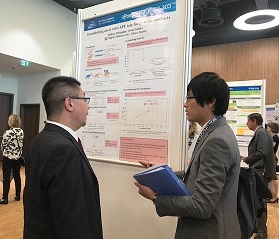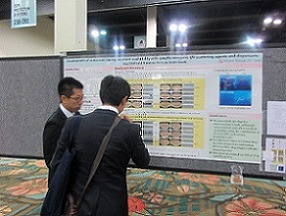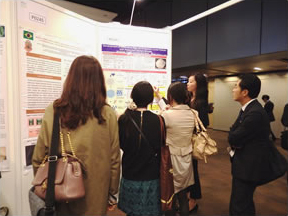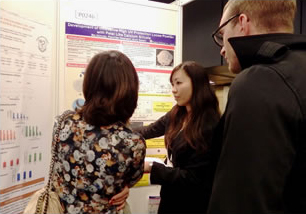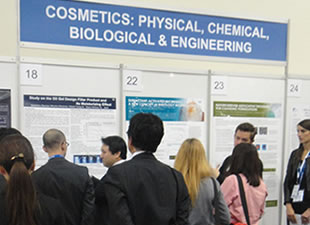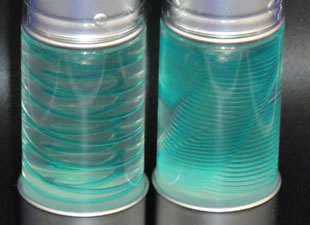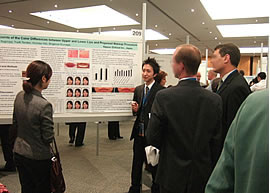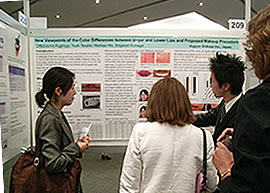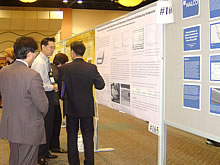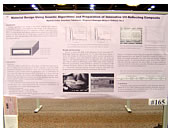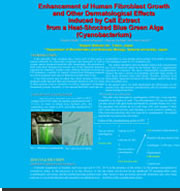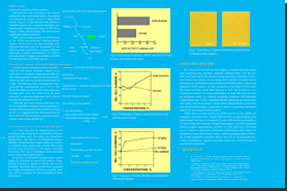
Nippon Shikizai is proud to present its international achievements gained through its own original research and development. Nippon Shikizai is attracting attention, globally, from their advanced research and development in cosmetic science and technology.
The IFSCC ( International Federation of Societies of Cosmetic Chemists ) is a worldwide federation dedicated to international cooperation in cosmetic science and technology. They host a biennial global congress for cosmetic products in selective major cities in the world. IFSCC has over 14,000 individual members from 45 countries.
Nippon Shikizai has been presenting its research to IFSCC for nine times, since 1994.
30th IFSCC Congress,Munchen 2018
At the 30th IFSCC Congress (International Federation of Societies Chemists) Nippon Shikizai announced the results of two technical development studies
Study 1Effect of Pressing on Oil-Wax Gel Structures and their Potential Applications to Cosmetics (Poster session)
It is important to control the structure of oil-wax gel used as a base in makeup cosmetics such as lipstick, foundation, and eye shadow because it significantly affects the sensory and stability of the product. In this study, we found that the structure of oil-wax gel can be changed by applying pressure and revealed its mechanism. Furthermore, we succeeded to develop foundation with unique sensory by applying the technology
Study 2In vitro SPF test for powder products and its correlation with the in vivo SPF value(Poster session)
Ultraviolet radiation has several harmful effects on human health that have recently recognized, leading to an increase in demand for sunscreen products in recent years. Ultraviolet irradiation defense capability of sunscreen products is measured by an in vivo SPF testing. However, an in vivo SPF testing is very expensive and time-consuming because it is conducted on human subjects. Therefore, accurately and effectiveness obtaining the in vivo SPF values is important. As predicting the in vivo SPF values, an in vitro SPF testing is being studied. In vitro SPF testing is cheaper and quick, because in vitro SPF values is measured using ultraviolet transmittance data. The studies of an in vitro SPF testing are being conducted for emulsion and oil products. However, studies of powder products have not been conducted yet. This is because creating a uniform layer is assumed to be difficult. In our research, we used solvent to create a uniform layer, and we successfully established an in vitro SPF testing that has high correlation with in vivo SPF values following the ISO 24444 standard.
29th IFSCC Congress,Orland 2016
At the 29th IFSCC Congress (International Federation of Societies Chemists) Nippon Shikizai announced the results of two technical development studies
Study 1Development of Ultimate POWDER Make-up Base(Poster session)
Many kinds of make-up base have been widely used mainly for the following three purposes; the correction of skin complexion, the improvement of adhesion between foundation and skin, and the protection from make-up deterioration. Further, they have an excellent moisture and a sheer finishing because most of them are made from emulsions. However, the texture of make-up becomes worse owing to excess oil and then make-up deterioration often occurs, when too much amount of them are applied on skin in order to obtain thorough effect. In this work, we focused on a powder system that was expected to incorporate a large amount of functional powder compared with a liquid system, and developed a highly effective powder make-up base with sheer finish and good feeling
Study 2Development of Sunscreen Having Excellent Washability with Specific Inorganic UV Scattering Agents and Dispersants(Poster session)
An increased awareness regarding the negative effects of ultraviolet (UV) rays on the skin has led to an increase in the use of sunscreen; two types of sunscreen?non-chemical and chemical?are present in the market. Non-chemical type has the characteristics of waterresistance and safety but is difficult to remove via ordinary cleansing; thus, special cleansing agents are needed to remove sunscreen from the skin. On the contrary, chemical type has the characteristics of washability and good texture although this type has a concern about skin irritation, depending on skin type. We developed a sunscreen having sufficient waterresistance and excellent washability by using the inorganic UV scattering agents treated with the N-acyl amino acid and specific dispersants
28th IFSCC Congress, Paris 2014
At the 28th IFSCC Congress (International Federation of Societies of Cosmetic Chemists) Nippon Shikizai announced the result of one technical development study.
StudyDevelopment of Innovative High UV Protection Loose Powder with Petal Like Calcium Silicate (Poster session)
Recently, cosmetic products with ultraviolet (UV) protection are in great demand on the market. Among them, loose powder type products have excellent characteristics such as easiness of reapplication and natural complexion finish. However it is difficult for loose powders to absorb the adequate amount of UV absorbers to achieve high UV protection because of the problems such as caking and cohesion. In this study these problems were solved by using petal-like calcium silicate (P-CS) as it has a high oil absorption value. Finally, we accomplished an innovative loose powder with both extremely high UV protection and an excellent texture and usability.
27th IFSCC Congress, Johannesburg 2012
At the 27th IFSCC Congress (International Federation of Societies of Cosmetic Chemists) Nippon Shikizai announced the result of one technical development study.
StudyStudy on the Oil Gel Design Filler Product and its Moisturizing Effect (Poster session)
Although water-based gel design filler products have been on the market for some time, most of these skin care formulation products are not sufficient in retaining moisture (low emollient properties) and maintain a design. In general, design filler products maintain a 3D design image within a transparent gel making a cosmetic product aesthetically appealing.
Our study on the rheological properties of oil-based gel design filler was performed to develop a better understanding and a process to enable better design drawing capabilities and emollient properties. The procedure was recognized as technically difficult to achieve but our results were the success of producing an oil-based design filler product with better emollient properties and drawing functions.
25th IFSCC Congress, Barcelona 2008
-
At the 25th IFSCC Congress (International Federation of Societies of Cosmetic Chemists) Nippon Shikizai announced the results of two technical development studies.
IFSCC is a global congress on cosmetic chemistry. The 25th IFSCC Congress took place in Barcelona, Spain for 4 days, starting on October 6.
At the biennially IFSCC Congress which is held in selective cities worldwide, Nippon Shikizai has presented research seven times, since 1994.
Nippon Shikizai was the first company to receive the opportunity of introducing scientific papers as a cosmetics contract manufacturing company at the IFSCC congress.
We presented the following research findings at IFSCC 2008:
Presentation of a formula technology that enables intricate cubed design on pressed powdery cosmetics, such as face powder.
Study 2Proposal for a new make-up technique to show lipstick’s color, beautifully on lips. Also included is a presentation of the technology development that enables this effect.
24th IFSCC Congress, Osaka 2006
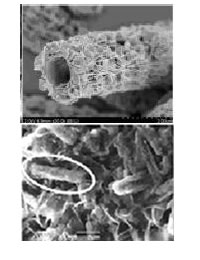
-
At the 24th IFSCC (International Federation of Societies of Cosmetic Chemists) Congress, Nippon Shikizai announced the study results of two technical developments.
One, regarding the evolution of lipsticks from a crystallographical study of botanical oil-wax structure, and the other study involving the Nanotechnology of powder material, respectively.
Crystallographical Study of Botanical Oil-wax Structure in Lipsticks and Control of its Stability
- Summary
- We found out that among various botanical waxes, a wax obtained from by-product of rice bran is efficient in the stabilization of botanical lipsticks.
Development of Lipsticks with Excellent Colorability by Formulating Microtubular Powder with Controlled Collapsibility
- Summary
- We discovered that new microtubular powder with controlled collapsibility at applying lipsticks makes it much easier to wear rouge and improves its colorability
(Joint development with Nittetsu Mining Co. Ltd)
23rd IFSCC Congress, Orlando 2004
-
Material Design using Genetic Algorithms and Preparation of Innovative UV-Reflecting Composite
Recently, various cosmetic materials such as “Light-Filtering” powder or “Foggy-effect” powder that covers skin’s imperfect feature e.g. spots, freckles etc have been studied and developed by using various kinds of technologies. In general, it is really difficult to design those kinds of materials because it is necessary to control particle size, shape, or other material nature. This means there is a need to consider huge factors and to repeat numerous complicated calculations in order to get an ultimate cosmetic material.
In this work, we made a blueprint (Figure 1) of the composite that accomplishes both the effective reflection of the UV light and the high transparency of the visible light by using the Genetic Algorithms (GA). GA is the method that incorporates the idea of the theory of evolution and gives us the optimized factors (superior individual) through following processes; selection, crossover and mutation. It is therefore an advanced method when there are huge amounts of factors that we need to consider.
Next, the composite was prepared in accordance with the blueprint (figure 2, 3). Further we found that it had an effective reflection of UV light while it had high transparency of visible light. Moreover, it had a better feeling-on-use compared with general ultra fine titanium dioxide. From these results, the composite is expected to become useful new UV-shielding pigment.

Figure 1 Blueprint of the ultimate UV-reflecting composite, obtained by using GA. 
Figure 2 SEM image of UV-reflecting composite. 
Figure 3 TEM (cross-section) image of UV-reflecting composite.
22nd IFSCC Congress, Edinburgh 2002
-
The property of stimulating the growth of fibroblasts and other useful potentials of cyanobacteria after a heat shock.
It is widely known that aging of the skin is caused externally by ultraviolet (UV) light and internally by reactive oxygen species (ROS) produced in the body. For anti-aging, it is an important challenge to prevent ROS from oxidizing living tissue of the body.
Aging, in its course, would negatively affect the growth and functions of fibroblasts, causing dermal changes, which in turn cause wrinkles and laxity. Cosmetics are expected to protect the skin from such damaging oxidization more effectively.
Our research presented this time is to study the effectiveness of the crude extract of cyanobacteria before and after heat shock for comparison. The cyanobacterium, found in hot spring, is thermophilic. The sample of cyanobacteria after heat shock is to be prepared by exposing to a higher temperature than the normal culture setting. The result shows that the cyanobacterium extract has such anti-activation property as SOD (superoxide dismutase) activity and inhibition of lipid peroxide formation. On the other hand, it is also found that the cyanobacterium extract after heat shock has the property of stimulating the growth of fibroblasts as well as these two anti-activation properties and that the SOD activity of the cyanobacterium extract shows great heating-resistance.
Based on these results, it is assumed that the cyanobacterium extract be of effective use as an ingredient of anti-aging cosmetics, and we expect new products and applications to be developed with the use of cyanobacteria in the anti-aging field.
IFSCC 20th Congress 1998 (Cannes)
Development of Titanium Dioxide-Containing Silicone Polymer and Applications in Cosmetics
IFSCC 19th Congress 1996 (Sydney)
Preparation of the Hollow Porous Titanium Dioxide Spheres with Controlled Collapsibility and its Properties
IFSCC 18th Congress 1994 (Venice)
Sol-Gel Preparation of Organic Colorant-Doped Silica Gel and its Properties
ASCS 1st Conference 1993 (Kobe)
Application of Porous Starch-Complex Powder



